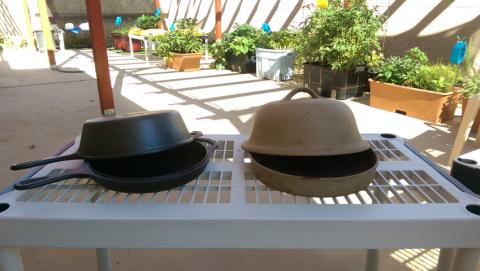August 9, 2017 - 10:19am

Lodge Combo Cooker vs Le Cloche

It's probably been done before but here goes. I'll compare the end results of baking 2 loaves ( recipe posted later) side by side, one in a Lodge Combo Cooker and the other in a stoneware Le Cloche. They are supposed to serve the same purpose, right. The dough creates its own steam. So my dough will be weighed and divided into 2 equal amounts. Baked side by side, same temp, same time.
My oven is residential propane fueled. My home is in the hot Mojave high desert (3500 ft elevation) which really should not be a factor? Post to ya later.


Comments
I'm actually at about the same elevation, and it definitely does have an impact on our baking vs sea level. The KAF site has some info on it:
http://www.kingarthurflour.com/learn/high-altitude-baking.html
I suspect that your lack of humidity could have an impact too, in that you might start out with higher hydration in the dough than what could be used in a more moist environment.
Regardless - the difference (if any) in the results between the two different baking vessels should be seen at any elevation or humidity.
As promised here they are. FWSY ("Flour Water Salt Yeast" by Ken Forkish) Country Brown recipe. Same dough weights baked side by side. Same time, same temp (475º F). A bit more oven spring in the Lodge ComboCooker and the seams ripped open. The Le Cloche boule did not split. Not sure why. The bottom got burned in the Lodge which is a common complaint with cast iron Dutch ovens. Maybe I should put the Combo Cooker on my baking stone next time.
An interesting variation I've noted in FWSY is that Forkish places his shaped boule seam side down in the banneton. Other bread book authors place the seam side up and then after inverting the boule on the baking stone, make the scoring patterns. Does it really matter??
Also I do not take the final 20 min bake to completion because I don't want the extreme dark brown crust color.
The reason is that after toasting such a slice of the really dark brown crust, it comes out of the toaster literally carbonized. Works for me.
Hi Tony, I have found that parchment rounds from Amazon or E-bay, have become my new best friend to stop burning in my dutch ovens and cast iron bread and pizza pans. As IceDemeter said, altitude does matter too. I am at 8,000 feet and I have to use higher hydration, and slightly longer baking times. I love the extra oven spring with the combo cooker. I think I'll get one of those! Carolynn
It's interesting to see the side-by-side comparison and see that apparently the combo cooker either gets a bit hotter or seals a bit better. Did you see any difference in the crumb, overall? Any chance of some crumb pics?
I'm not surprised to see the darker bottom crust, but a bit of parchment paper (which can be re-used) or even a small silicon baking mat inside would correct that problem.
There really is no reason to choose "proof seams down / bake seams up no scoring" over "proof seams up / bake seams down and score" other than for how you want the loaf to look. It doesn't look like an issue for you, but for some new bakers that have issues with shaping and getting a good, tight skin, it can make it a lot easier to get a good result (with no side blow-outs) if they can count on the loaf expanding at the seams. Besides, the more rustic look of burst seams is more fashionable in some places than the more structured result from a scoring pattern...
I LOVE that you choose to not follow the bake instructions to the letter, and bake a bit less to get the crumb colour / texture / flavour that YOU want for YOUR bread in YOUR kitchen! It saddens me to so often see people posting about following recipes to the letter and not being happy with the results, but unwilling to stray from what the "expert" told them to do... What is the point and what kind of fun is it if you can't play with it to get what you want?!
Again - nice job, and thanks so much for sharing!
Both loaves show a similar crumb pattern. Rather compact closed cell structure and quite moist (but not under baked). I prefer this type of crumb rather than the huge open cells so typical of a ciabatta. The taste is good and the untoasted crust very chewy. I wonder how it would go with a dollop of butter spread over a slice. Or maybe a warm chunk dipped in flavored EVVO?
Congrats on a well run experiment!
I also bake to a lighter color than is currently fashionable, and for the same reason. I just love the toast made from my bread, and so does my family. It stays hot, and the crunch can be heard from across the room...
I think some butter on this bread would be an excellent idea!
Hadster